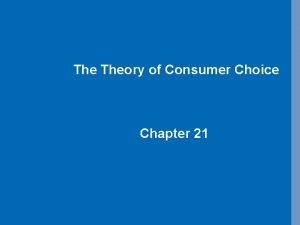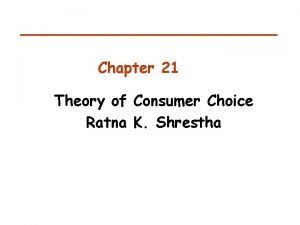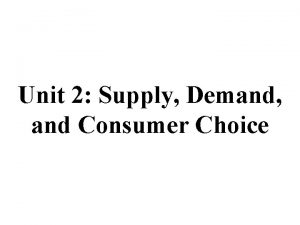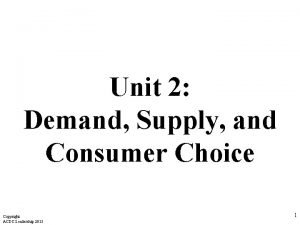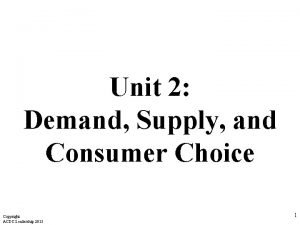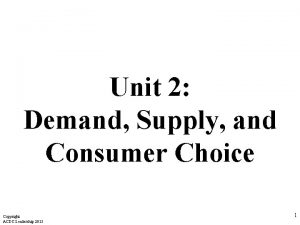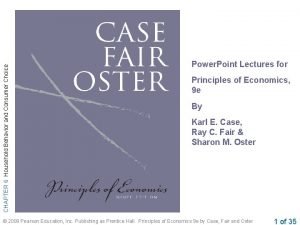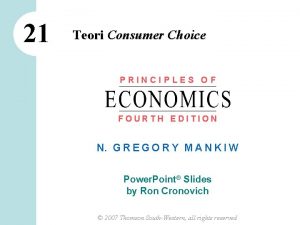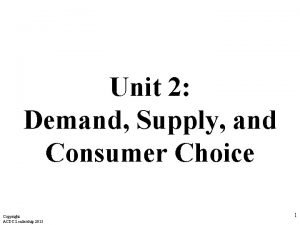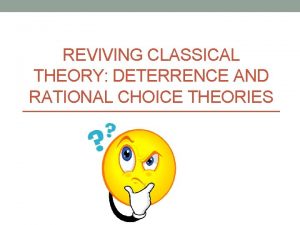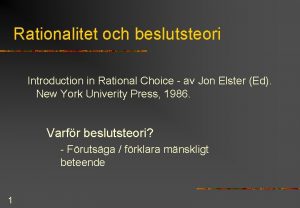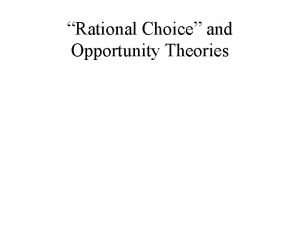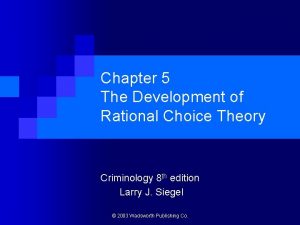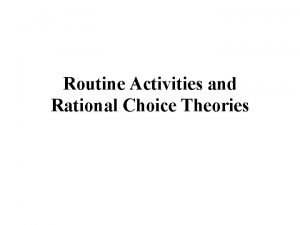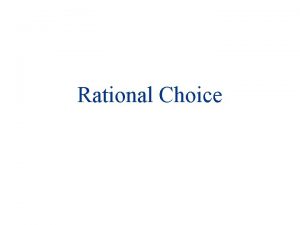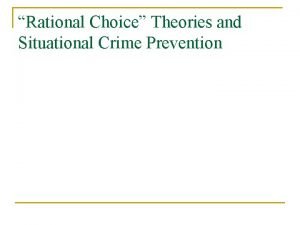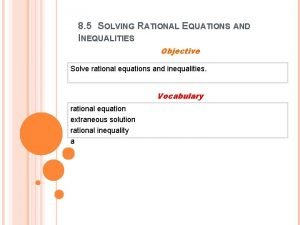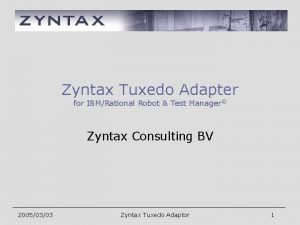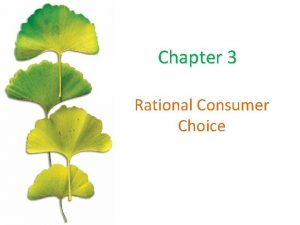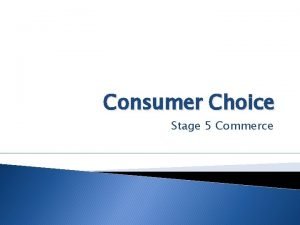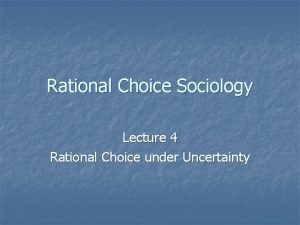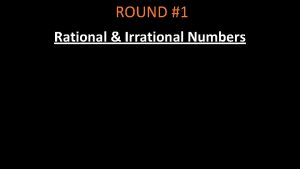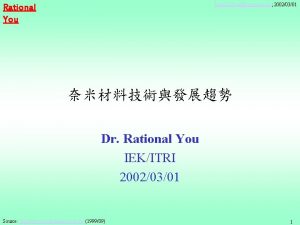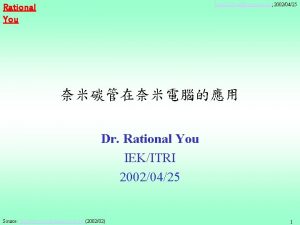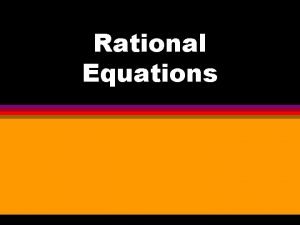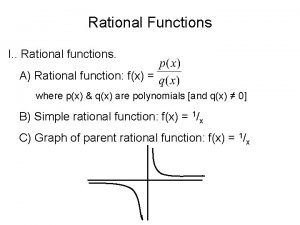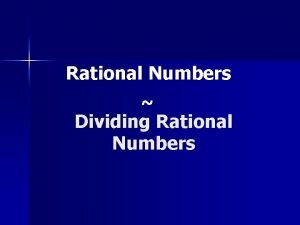Chapter 3 Rational Consumer Choice Chapter Outline The








































- Slides: 40

Chapter 3 Rational Consumer Choice

Chapter Outline • • • The Opportunity Set or Budget Constraint Budget Shifts Due to Price or Income Changes Consumer Preferences The Best Feasible Bundle Appendix: – The Utility Function Approach to the Consumer Choice – Cardinal versus Ordinal Utility – Generating Indifference Curves Algebraically © 2015 Mc. Graw-Hill Education. All Rights Reserved. 2

Budget Limitation • A bundle: a particular combination of two or more goods. • Budget constraint: the set of all bundles that exactly exhaust the consumer’s income at given prices. – Its slope is the negative of the price ratio of the two goods. © 2015 Mc. Graw-Hill Education. All Rights Reserved. 3

Figure 3. 1: Two Bundles of Goods © 2015 Mc. Graw-Hill Education. All Rights Reserved. 4

Affordable vs. Unaffordable • Affordable set, or feasible set: bundles on or below the budget constraint; bundles for which the required expenditure at given prices is less than or equal to the income available. • Unaffordable set, or unfeasible set: bundles that lie outside the budget constraint © 2015 Mc. Graw-Hill Education. All Rights Reserved. 5

Figure 3. 2: The Budget Constraint, or Budget Line © 2015 Mc. Graw-Hill Education. All Rights Reserved. 6

Budget Shifts Due to Price and Income Changes • If the price of ONLY one good changes… – The slope of the budget constraint changes. • If the price of both goods change by the same proportion… – The budget constraint shifts parallel to the original one. • If income changes …. – The budget constraint shifts parallel to the original one. © 2015 Mc. Graw-Hill Education. All Rights Reserved. 7

Figure 3. 3: The Effect of a Rise in the Price of Shelter © 2015 Mc. Graw-Hill Education. All Rights Reserved. 8

Figure 3. 4: The Effect of Cutting Income by Half © 2015 Mc. Graw-Hill Education. All Rights Reserved. 9

Budgets Involving More Than Two Goods • When we have more than 3 goods, the budget constraint becomes a hyperplane, or multidimensional plane. • In this case, view the consumer’s choice as one between a good, X, and an amalgam of other goods, Y. This amalgam is called the composite good. – The amount of income left after buying good X – The amount the consumer spends on goods other than good X © 2015 Mc. Graw-Hill Education. All Rights Reserved. 10

Figure 3. 5: The Budget Constraints with the Composite Good © 2015 Mc. Graw-Hill Education. All Rights Reserved. 11

Figure 3. 6: A Quantity Discount Gives Rise to a Nonlinear Budget Constraint © 2015 Mc. Graw-Hill Education. All Rights Reserved. 12

Figure 3. 7: Budget Constraints Following Theft of Gasoline, Loss of Cash © 2015 Mc. Graw-Hill Education. All Rights Reserved. 13

Preference Ordering • Preference ordering: a ranking of all possible consumption bundles in order of preference. – Differ widely among consumers – Four simple properties of preference ordering © 2015 Mc. Graw-Hill Education. All Rights Reserved. 14

Properties of Preference Orderings • Completeness: the consumer is able to rank all possible combinations of goods and services. • More-Is-Better: other things equal, more of a good is preferred to less. • Transitivity: for any three bundles A, B, and C, if he prefers A to B and prefers B to C, then he always prefers A to C. • Convexity: mixtures of goods are preferable to extremes. © 2015 Mc. Graw-Hill Education. All Rights Reserved. 15

Figure 3. 8: Generating Equally Preferred Bundles © 2015 Mc. Graw-Hill Education. All Rights Reserved. 16

Indifference Curves • Indifference curve: a set of bundles among which the consumer is indifferent. • Indifference map: a representative sample of the set of a consumer’s indifference curves, used as a graphical summary of her preference ordering. © 2015 Mc. Graw-Hill Education. All Rights Reserved. 17

Properties of Indifference Curves • Indifference curves … 1. Are Ubiquitous. • Any bundle has an indifference curve passing through it. 2. Are Downward-sloping. • This comes from the “more-is-better” assumption. 3. Cannot cross. 4. Become less steep as we move downward and to the right along them. • This property is implied by the convexity property of preferences. © 2015 Mc. Graw-Hill Education. All Rights Reserved. 18

Figure 3. 9: An Indifference Curve © 2015 Mc. Graw-Hill Education. All Rights Reserved. 19

Figure 3. 10: Part of an Indifference Map © 2015 Mc. Graw-Hill Education. All Rights Reserved. 20

Figure 3. 11: Why Two Indifference Curves Do Not Cross © 2015 Mc. Graw-Hill Education. All Rights Reserved. 21

Trade-offs Between Goods • Marginal rate of substitution (MRS): the rate at which the consumer is willing to exchange the good measured along the vertical axis for the good measured along the horizontal axis. – Equal to the absolute value of the slope of the indifference curve. © 2015 Mc. Graw-Hill Education. All Rights Reserved. 22

Figure 3. 12: The Marginal Rates of Substitution © 2015 Mc. Graw-Hill Education. All Rights Reserved. 23

Figure 3. 13: Diminishing Marginal Rate of Substitution © 2015 Mc. Graw-Hill Education. All Rights Reserved. 24

Figure 3. 14: People with Different Tastes © 2015 Mc. Graw-Hill Education. All Rights Reserved. 25

The Best Feasible Bundle • Consumer’s Goal: to choose the best affordable bundle. – The same as reaching the highest indifference curve she can, given her budget constraint. – For convex indifference curves. . • the best bundle will always lie at the point of tangency. © 2015 Mc. Graw-Hill Education. All Rights Reserved. 26

Figure 3. 15: The Best Affordable Bundle © 2015 Mc. Graw-Hill Education. All Rights Reserved. 27

Corner Solutions • Corner solution: in a choice between two goods, a case in which the consumer does not consume one of the goods. © 2015 Mc. Graw-Hill Education. All Rights Reserved. 28

Figure 3. 16: A Corner Solution © 2015 Mc. Graw-Hill Education. All Rights Reserved. 29

Figure 3. 17: Equilibrium with Perfect Substitutes © 2015 Mc. Graw-Hill Education. All Rights Reserved. 30

Cash or Food Stamps? • Food Stamp Program – Objective - to alleviate hunger. – How does it work? • People whose incomes fall below a certain level are eligible to receive a specified quantity of food stamps. • Stamps cannot be used to purchase cigarettes, alcohol, and various other items. • The government gives food retailers cash for the stamps they accept. © 2015 Mc. Graw-Hill Education. All Rights Reserved. 31

Figure 3. 18: Food Stamp Program vs. Cash Grant Program © 2015 Mc. Graw-Hill Education. All Rights Reserved. 32

Figure 3. 19: Where Food Stamps and Cash Grants Yield Different Outcomes © 2015 Mc. Graw-Hill Education. All Rights Reserved. 33

The Utility Function Approach to Consumer Choice • Finding the highest attainable indifference curve on a budget constraint is just one way to analyze the consumer choice problem • In this second approach, we represent the consumer’s preference not with an indifference map, but with a utility function. © 2015 Mc. Graw-Hill Education. All Rights Reserved. 34

Figure A 3. 1: Indifference Curves for the Utility Function U=FS © 2015 Mc. Graw-Hill Education. All Rights Reserved. 35

Figure A 3. 2: Utility Along an Indifference Curve Remains Constant © 2015 Mc. Graw-Hill Education. All Rights Reserved. 36

Figure A 3. 3: A Three-Dimensional Utility Surface © 2015 Mc. Graw-Hill Education. All Rights Reserved. 37

Figure A 3. 4: Indifference Curves as Projections © 2015 Mc. Graw-Hill Education. All Rights Reserved. 38

Figure A 3. 5: Indifference Curves for the Utility Function U(X, Y)=(2/3)X + 2 Y © 2015 Mc. Graw-Hill Education. All Rights Reserved. 39

Figure A 3. 6: The Optimal Bundle when U=XY, Px=4, Py=2, and M=40 © 2015 Mc. Graw-Hill Education. All Rights Reserved. 40
 Food chain primary and secondary consumers
Food chain primary and secondary consumers The theory of consumer choice chapter 21 practice
The theory of consumer choice chapter 21 practice Chapter 21 the theory of consumer choice
Chapter 21 the theory of consumer choice Good choice or bad choice
Good choice or bad choice Unit 2 demand supply and consumer choice
Unit 2 demand supply and consumer choice Unit 2 demand supply and consumer choice
Unit 2 demand supply and consumer choice Unit 2 demand supply and consumer choice
Unit 2 demand supply and consumer choice Unit 2 demand supply and consumer choice answer key
Unit 2 demand supply and consumer choice answer key Two household chapter 6
Two household chapter 6 Consumer choice theory adalah
Consumer choice theory adalah Unit 2 demand supply and consumer choice
Unit 2 demand supply and consumer choice Unit 2 demand supply and consumer choice
Unit 2 demand supply and consumer choice Desert herbivore
Desert herbivore Cengage
Cengage Consumer research process
Consumer research process Buyer behaviour
Buyer behaviour Chapter 5 consumer markets and buyer behavior
Chapter 5 consumer markets and buyer behavior Deterrence and rational choice theory of crime
Deterrence and rational choice theory of crime Rational choice teori
Rational choice teori Rational choice theory
Rational choice theory Rational choice theory criminology
Rational choice theory criminology Routine activity and rational choice
Routine activity and rational choice Rational constrained choice
Rational constrained choice Rational choice theory key concepts
Rational choice theory key concepts Oscar rational consumer
Oscar rational consumer Neeru meaning
Neeru meaning Solving rational equations and inequalities
Solving rational equations and inequalities Ibm rational robot
Ibm rational robot Sandwich quote example
Sandwich quote example Hình ảnh bộ gõ cơ thể búng tay
Hình ảnh bộ gõ cơ thể búng tay Bổ thể
Bổ thể Tỉ lệ cơ thể trẻ em
Tỉ lệ cơ thể trẻ em Chó sói
Chó sói Glasgow thang điểm
Glasgow thang điểm Chúa yêu trần thế
Chúa yêu trần thế Các môn thể thao bắt đầu bằng từ đua
Các môn thể thao bắt đầu bằng từ đua Thế nào là hệ số cao nhất
Thế nào là hệ số cao nhất Các châu lục và đại dương trên thế giới
Các châu lục và đại dương trên thế giới Công thức tiính động năng
Công thức tiính động năng Trời xanh đây là của chúng ta thể thơ
Trời xanh đây là của chúng ta thể thơ

